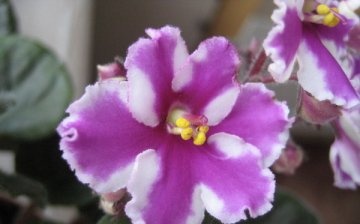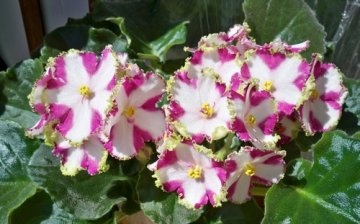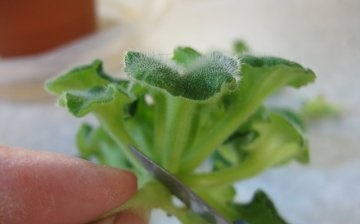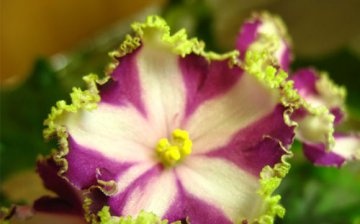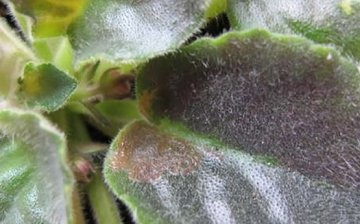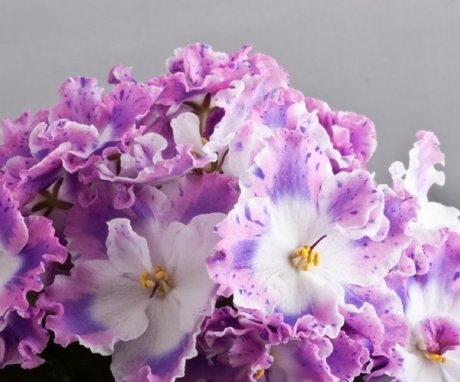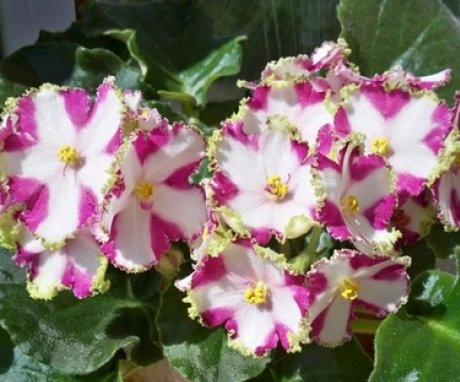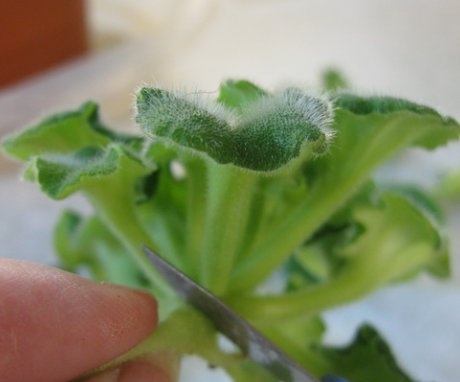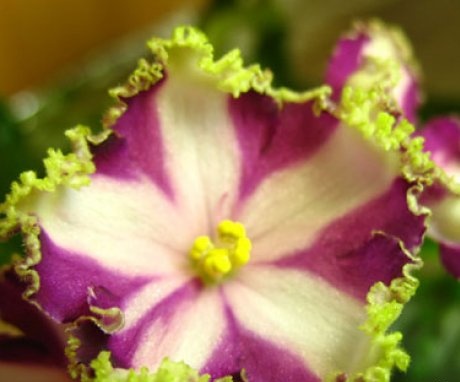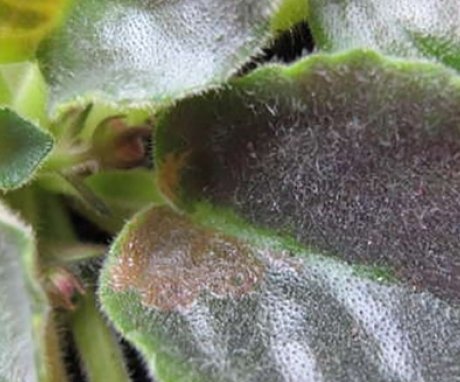Chimera violets: popular varieties and growing rules
beauty violets attracts many flower lovers, and the variety of varieties makes us grow more and more options on the windowsills. But the history of this delicate flower goes back to the end of the 19th century, when it was first described. Since that time, breeders do not get tired of breeding more and more new types of violets of the most intricate colors.
Over the past century, so many new varieties have appeared that it seems that the fantasy of nature should be exhausted, but no, exclusive Saintpaulias continue to amaze with their uniqueness. This is especially characteristic of the chimera violet, or uzambar, as it is called.
Content:
- Species features of violets chimeras
- Varietal variety of the uzambar violet
- Flower reproduction methods and planting rules
- Basic tips for caring for a unique flower
- Pest Control and Disease Prevention of Violet Chimera
Species features of violets chimeras
Chimeras this kind violets called because during reproduction you can get plants with different genetic characteristics, completely different from the mother flower. Petals of various colors and shapes have a clear white or light-colored strip with dusting or strokes in the center or along the edges, contrasting with the main color. Chimera corollas are characterized by sectors that are differently colored and emerge from the center of the violet.
Chimeric flowers are in the middle of a symmetrical rosette of dark green rounded leaves, usually with a velvety surface. The difference between violets of this species from others is that as a result of mutations from any flower, you can get the only unique specimen of its kind. And one cannot be sure whether the father will pass on his external data to the offspring.
Depending on the growing conditions, the color of the chimera violet also changes.
The presence of the plant in rooms with constantly high temperatures leads to the uniformity of the shades of the petals. The restoration of their original appearance will occur when a favorable environment is created. All components of growth - adequate lighting, nutrient composition of the soil and temperature without sudden changes - will make the colors of the flower bright.
Chimera violets are very capricious, unpredictable, but many want to work on growing this particular species.
Varietal variety of violet chimera
The breeding of violets of this species developed rapidly, especially in America, and now Saintpaulias have been created for collections, for growing on an industrial scale, so we will consider only the main varieties:
- The Icy Hot variety is uncomplicated in appearance - color petals similar to pansies in shape fuchsia with a pure white stripe in the middle on a rosette of light green leaves with wavy whitish edges.
- Mandy flowers are similar in appearance to white stars, from the middle of which a blue stripe is drawn to each ray.
- The large white petals of the Myrte violet are decorated with stripes of bright crimson in the center.
- Princess KRei has regal white flowers, smeared with traces of fuchsia and slightly shaded in blue in the middle.
- Robs Monkeyshines' semi-miniature violets are distinguished by soft and purple colors, white rays in the center and fancy touches of blue.
- In the Tineke variety, the petals are simple in shape and uncomplicated in color: a lilac stripe on a light pink background.
- Saintpaulias Victorian Parasol is characterized by large flowers, simple and semi-double, dark purple, decorated with a light stripe along the edges and in the center of the petals. Light green leaves with a wavy edge complete the picture.
Not all varieties are resistant to their traits. Therefore, you need to adjust yourself to the fact that in the future the grown flower may look completely different.
Flower reproduction methods and planting rules
Just with a leaf, like ordinary violets, Saintpaulias do not reproduce. Consider the most effective ways to reproduce chimeric flowers:
- The first method is based on the fact that the violet peduncle has a bracts with a dormant bud, a stepson. Having separated it neatly, it is planted in a separate container with pre-disinfected soil for rooting. The main thing here is to create certain conditions for this by placing the sprout in a self-constructed box made of a bottle or film. This will help maintain a moist atmosphere inside. This method of reproduction is not always effective, but there is no risk to the plant itself. In terms of duration, this method is also not suitable for everyone, especially impatient in nature, because the transplanted peduncle will become an adult only after a year, then it will bloom.
- Reproduction through cutting off the head of an adult plant is often used. The procedure is carried out below the growing point, capturing several rows of leaves. After six months, another chimeric plant can be obtained from the separated part. But pruning the top should be carried out at a fairly mature flower, in which several rows of leaves have already formed to the end. A small number of stepchildren will soon appear on the remaining hemp, which also does not favor this method of reproduction, although the peduncles will grow quickly and give new plants.
By destroying the growth point of the chimera, a person promotes the rapid formation of stepchildren. But it will take a lot of time before getting adult flowering Saintpaulias - about ten months. Once every two months, it is necessary to remove the grown-up stepsons, leaving only immature babies on the mother's body.
When boarding children violets it is necessary to remember about the size of the pot, which should not exceed much in diameter the rosette of the flower, but be at least 9 centimeters. The material for the container can be made of plastic and ceramics. At the bottom, it is necessary to lay a drainage layer in the form of expanded clay, pieces of foam, which will help the water not to stagnate in the pot.
The soil for the flower should be loose and nutritious.
If these planting rules are observed, the rooting of the stepsons will be successful. All methods of reproduction are capable of increasing the offspring of violets of the chimera species, but for this you need to be patient.
Basic tips for caring for a unique flower
Saintpaulias, chimera violets, came from the tropics, look delicate, and therefore require special care. In watering, it is necessary to observe moderation, because excessive moisture for the plant is fatal. Recommends to use more often watering from the pallet, when the container with the violet is immersed in wet sand or other moisture-filled substrate.
Top dressing the violet chimera loves, especially in the offseason. Fertilized with minerals and organics in a complex, such mixtures are purchased specifically for violets in stores.
Saintpaulia pots are placed in rooms with good lighting, but not in direct sunlight.
Drafts are dangerous for the plant, but it is imperative to ventilate the room. The temperature regime should be under constant control, without sharp fluctuations, not lower than plus 18 in winter, and higher in summer. Care violets the type of chimera is not so difficult, they just require a certain amount of attention, like any plant.
Pest Control and Disease Prevention of Violet Chimera
Pests the indoor flower has a little, but they can destroy it. The most dangerous are thrips, an insect that infects the anthers of a flower, and worms that sit in the ground, harming the roots of the violet. You can fight these pests by spraying plants are double insecticide. If spots appeared on the leaves, first light, and then brown, it means that the nematodes attacked the favorite plant. They destroy both the buds and the growth points of the flower. Affected nematodes the leaves and roots of the violet chimera will not be able to recover, so it is better to get rid of the plant.
Improper care, especially excessive watering, leads to the appearance of myceliums in the soil, which begin to spread in low light and low air temperatures.
From here, root rot begins, in which leaves and flowers turn brown and dry. There are more mushrooms, they begin to live, feeding on the juices of the plant. In winter, you can see that the leaves of the flower turn brown, then fall off, and the roots are completely rotten. This means that the violet fell ill with fusarium caused by a special kind of mushrooms from the ground.
The ingress of water on the leaves also leads to a disease characterized by brown bloom and decay of the foliage. Over time, a gray bloom appears on the dying parts, covering the entire large area of various parts of the violet, from flowers to growth points. Usually, the flower dies from a disease called gray rot, and it is caused by a fungus that develops in plant debris.
The main preventive action in this case is soil disinfection before planting a houseplant:
- Take the container with soil to the balcony in frosty weather or put it in the freezer for freezing for a week.
- A weak solution of potassium permanganate will also suppress infection and kill fungi that live in the ground.
Only compliance with the rules of soil disinfection before planting violets can save it from death in the future.
More information can be found in the video:



